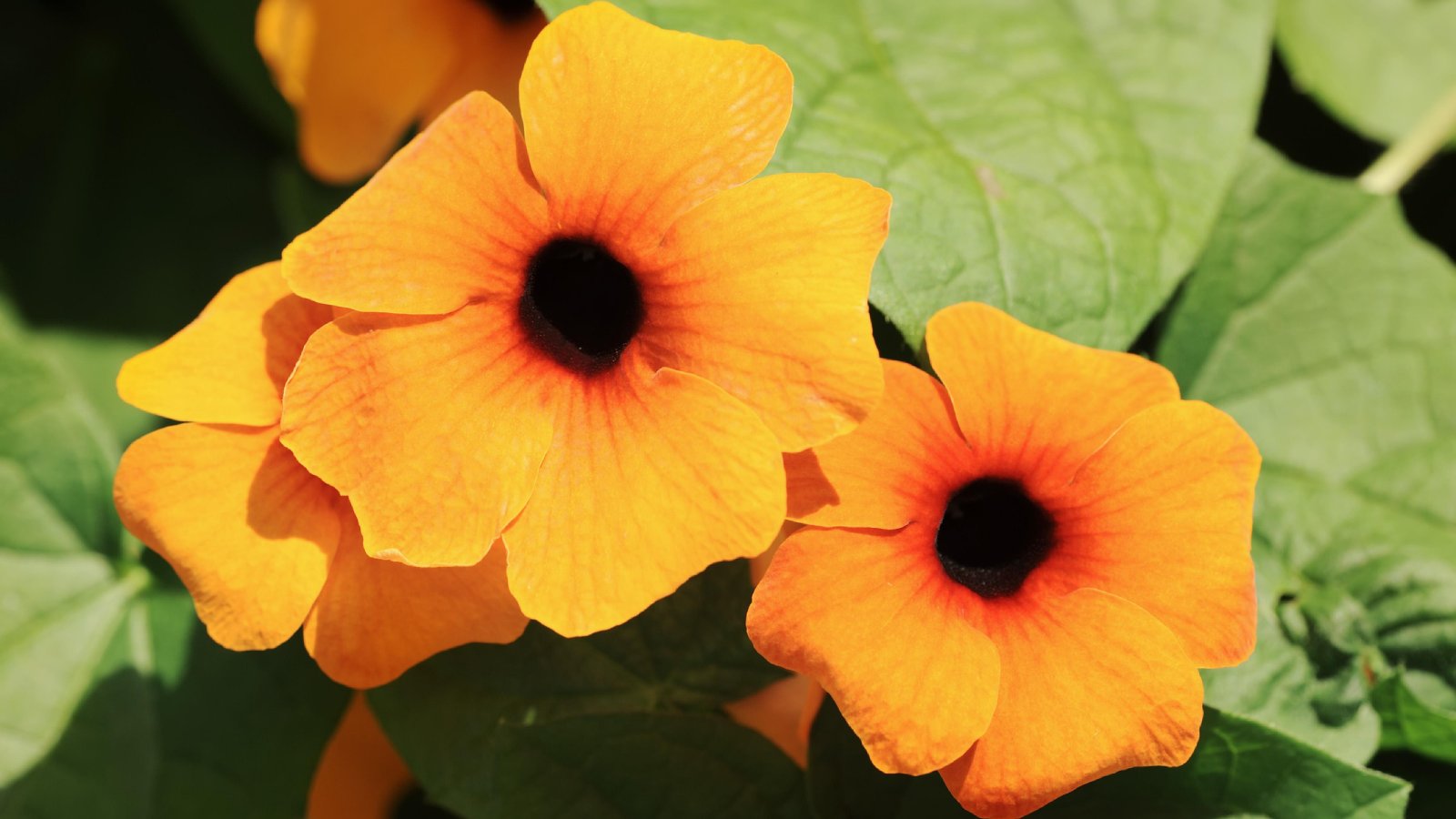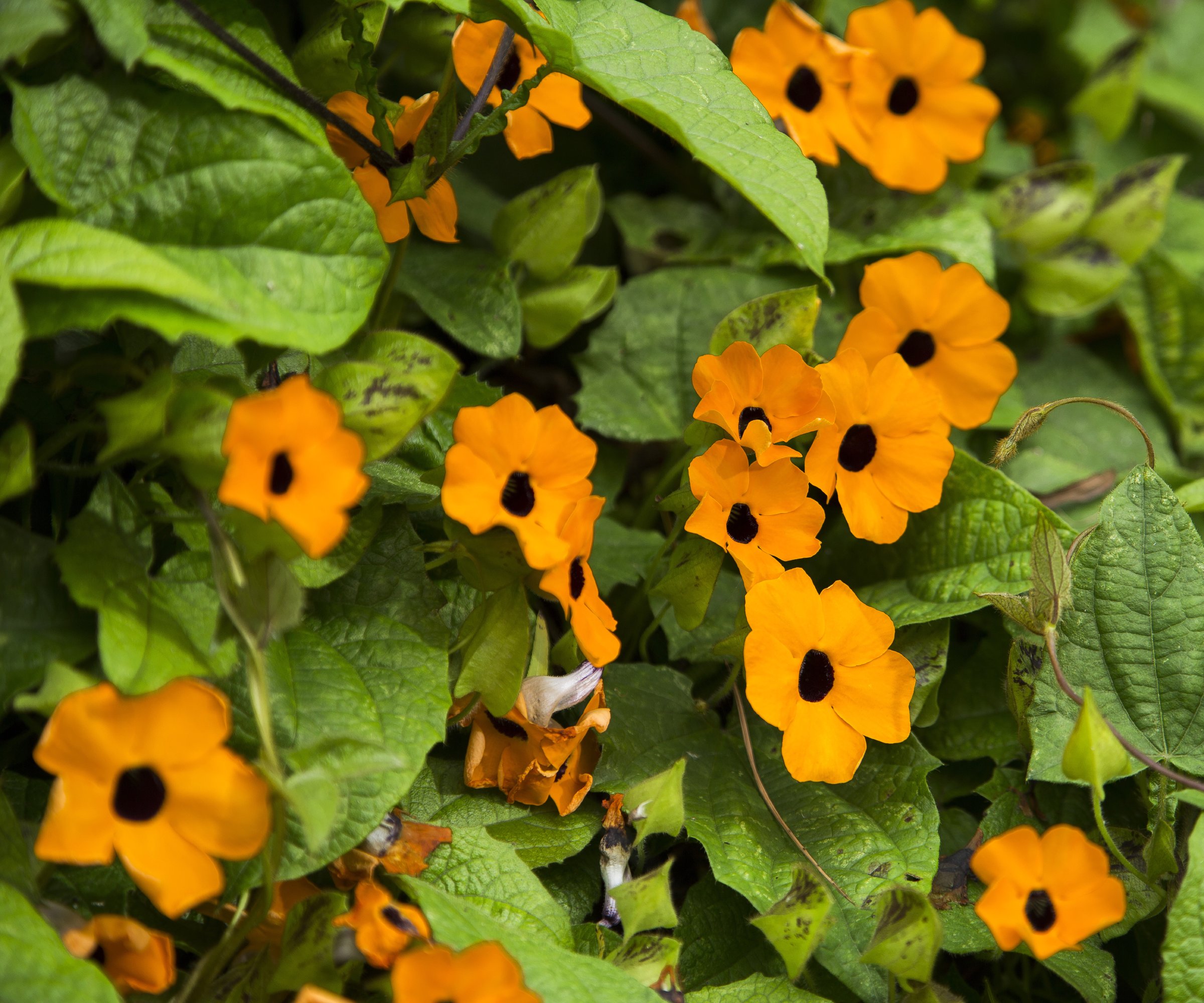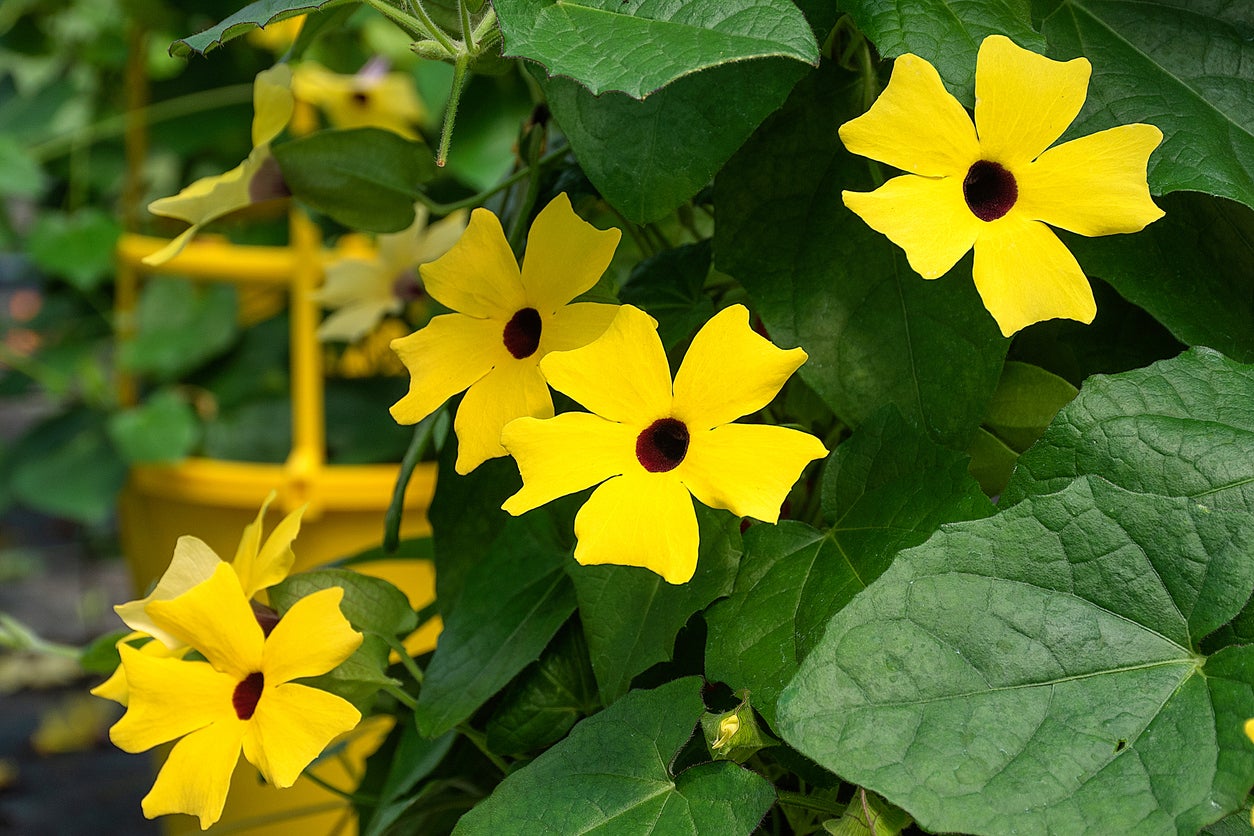Black Eyed Susan Vine Care - Tips For Growing A Black Eyed Susan Vine
Not to be confused with the similarly named perennial, black eyed Susan vines are beautiful, trailing plants that brighten up any garden.

- Caring for Black Eyed Susan Vine
- Light Conditions
- Temperature and Humidity
- Watering Needs
- Fertilizing
- Soil and Compost
- When and How to Plant Black Eyed Susan Vine
- Supporting and Training Black Eyed Susan Vine
- Black Eyed Susan Vine Pruning
- Problems, Pests, & Diseases
- How to Propagate a Black Eyed Susan Vine
- Best Black Eyed Susan Vine Varieties
- Frequently Asked Questions
Sometimes referred to as Thunbergia, black eyed Susan vines are used to adorn trellises, attract pollinators, and brighten otherwise drab garden spaces. A native of Africa, flowers grown in frost-free regions will behave as a short-lived perennial. However, their quick growth makes them an ideal candidate for annual beds, as well.
Caring for Black Eyed Susan Vine

Quick Black Eyed Susan Vine Facts
Botanical name – Thunbergia alata
Height – 3-8 ft (1.0-2.4 m)
Spread – 3-6 ft (1.0-1.8 m)
Sun exposure – Full Sun
Soil requirements – Neutral, Slightly Acidic, Slightly Alkaline
Hardiness zones – USDA Zones 10-11, Annual Elsewhere
When to plant – Spring
Stems and leaves are green and flowers are usually a deep yellow, white or orange with black centers. There are also red, salmon and ivory flowered varieties. Black eyed Susan is a fast growing vine that needs a vertical stand or trellis to support the plant. The vines twine around themselves and anchor the plant to vertical structures.
Light Conditions
When it comes to black eyed Susan vine, plants will grow best under full-sun conditions. This means that they should receive at least 6-8 hours of direct light each day. Vines can be grown in beds that are shaded, though they won't grow as long or flower as profusely.
Temperature and Humidity
Black eyed Susan vines thrive where conditions remain warm. Before planting outdoors, make sure both day- and night-time temperatures remain consistently above 50F (10C). Soils should also have been allowed to warm sufficiently, to at least 60F (15C). Though adaptable to a wide range of humidity, plants may struggle where weather is especially dry.
Watering Needs
Routine watering will aid in growth as well as the production of flowers. Make sure to saturate plants deeply, at their root zone. Avoid overwatering, as vines won't tolerate beds that are excessively wet.
Fertilizing
Though optional, applications of a well-balanced fertilizer can be used to promote bloom. Vines should be fed early, before the production of buds. Routine fertilization can continue every 4-6 weeks. You should avoid over-feeding, though, as it can result in excessive leafy growth and diminished flowering.
Soil and Compost
Black eyed Susan vines grow best in warm, well-amended beds. The plants are adapted to a wide range of soil conditions, including those that are neutral, slightly acidic, or slightly alkaline. Finished compost and other amendments can be added at planting time, as needed, according to the specific needs of one’s own space. Good drainage is essential, with vines thriving where soils remain consistently moist.
Gardening tips, videos, info and more delivered right to your inbox!
Sign up for the Gardening Know How newsletter today and receive a free copy of our e-book "How to Grow Delicious Tomatoes".
When and How to Plant Black Eyed Susan Vine
Growing black eyed Susan vine from seed is a quick and easy way to add seasonal beauty to the home landscape. Seeds are best sown in spring. Though they can be started indoors, most prefer to sow them directly into the garden. This can be done after all chances of frost have passed and the soil has warmed sufficiently. Black eyed Susan vine seedlings should begin to emerge in as little as 5-7 days from planting. Vines will start to heighten within the first few weeks, requiring support to continue their climb.
Supporting and Training Black Eyed Susan Vine
Black eyed Susan vines climb by twining. This means that the best supports for the plants are those which it is able to spiral up. Examples of such supports include various types of garden twine, trellises, arbors, and stakes. As plants can reach impressive heights, supports should be secured well and able to easily hold the weight of mature vines.
Black Eyed Susan Vine Pruning
Black eyed Susan vines are relatively carefree and require only little pruning. In fact they'll continue blooming throughout the season without the need for deadheading. Though large plants can be trimmed or pruned to control their size, it is not needed to promote new growth or the production of flowers.
Problems, Pests, & Diseases
Black eyed Susan vines only seldom have issues with pests or disease. That doesn't mean they're problem free, though. Powdery mildew is most common, but can be controlled by the removal of infected leaves and/or use of various treatments. Watch for pests like whitefly, scale or mites and combat with horticultural soap or neem oil.
How to Propagate a Black Eyed Susan Vine
You can grow a black eyed Susan vine from seed.
Growing a black eyed Susan vine from cuttings is easier. Overwinter the plant by cutting several inches from a terminal end of a healthy plant. Remove the bottom leaves and place in a glass of water to root. Change the water every couple of days.
Once you have thick roots, plant the start in potting soil in a pot with good drainage. Grow the plant until spring and then transplant outdoors when temperatures warm up and there is no possibility of frost.
Best Black Eyed Susan Vine Varieties
- ‘African Sunset’ Black eyed Susan Vine - Consisting of yellow-blush blooms, ‘African Sunset’ is praised for its delightful color and unyielding ability to cover obelisks and trellises. This is an excellent black eyed Susan vine for containers.
- ‘Bright Eyes’ Black eyed Susan Vine - ‘Bright Eyes’ is sure to make a statement. With pristine white flowers, this cultivar stands out among the most unique types of black eyed Susan vines available to home gardeners. Its high contrast makes it an attractive addition to mixed borders and hanging baskets.
- ‘Sunny Susy Amber Stripes’ Black eyed Susan Vine - Like most varieties, ‘Sunny Susy Amber Stripes’ offers an array of brilliantly-colored flowers. Lush foliage and red-orange blooms make for an attractive groundcover that is well-suited to a warm garden palette.
- ‘Superstar Orange’ Black eyed Susan Vine - Producing among the largest blooms of any variety, orange flowers put on a vibrant display throughout summer. ‘Superstar Orange’ is an exceptionally popular choice for pollinator gardens and for those hoping to attract hummingbirds.
Frequently Asked Questions
Is Black Eyed Susan Vine a Perennial?
Within its hardiness range, black eyed Susan vine can be grown as a short-lived perennial. However, the plant is commonly treated as an annual outside of these frost-free regions. This is thanks to the plant’s habit of rapid growth and ability to flower from seed within a single season.
Is Black Eyed Susan Vine Poisonous?
Though little information is available online in regards to whether or not the vine is considered poisonous, plants do contain various toxins. Mild toxicity has been reported in some livestock that have consumed the plant, therefore, care should be taken in gardens frequented by children, pets, and other special populations.

Tonya Barnett has been gardening for 13 years. Flowers are her passion. She has transformed her backyard into a cut flower garden, which she regularly chronicles on her YouTube channel http://www.youtube.com/@tonyawiththeflowers.
-
 Looking For Plants To Give You The Soft And Fuzzies? Try These 5 Fuzzy Leaf Plant Options
Looking For Plants To Give You The Soft And Fuzzies? Try These 5 Fuzzy Leaf Plant OptionsLovers of texture, drama, silver foliage and tactile plants will adore these special sensory garden additions. These fuzzy leaf plant options will leave you all aglow
By Susan Albert
-
 Get Ready For A Summer Of Hummers! Grow These Full Sun Hummingbird Plants and Flowers
Get Ready For A Summer Of Hummers! Grow These Full Sun Hummingbird Plants and FlowersIf you’re lucky enough to enjoy a sunny backyard, make sure you are maxing out on your pollinator opportunities and grow these full sun hummingbird plants and flowers
By Tonya Barnett

